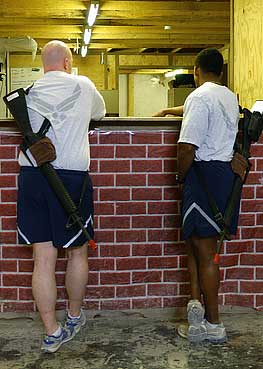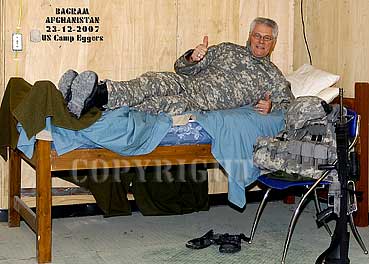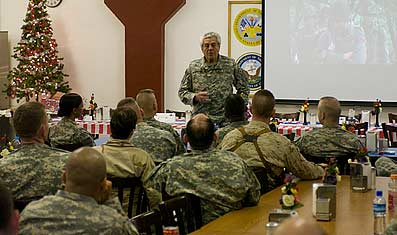



Bagram Airbase is located in the Parvan Province approximately 11 kilometers (7 miles) southeast of the city of Charikar and 47 Kilometers (27 miles) north of Kabul. It is served by a 10,000 foot runway built in 1976 capable of landing large cargo and bomber aircraft.
Bagram Airbase has three large hangars, a control tower, and numerous support buildings. There are over 32 acres of ramp space. There are five aircraft dispersal areas with a total of over 110 revetments. Many support buildings and base housing built by the Soviets, have been destroyed by years of fighting between the various warring Afghan factions.
Bagram Airbase played a key role during the Soviet occupation of Afghanistan, serving as a base of operations for troops and supplies. and Aircraft based at Bagram provided close air support for Soviet and Afghan troops in the field. Some of the Soviet forces based out of Bagram included the elite 105th Guards Airborne Division.
While the eight-section temper tents being replaced held 16 to 24 airmen, the new B-huts (below) hold eight occupants, enabling more personal living space. Because of space limitation in Bagram's Air Force Village, plans called for some airmen to be double bunked temporarily to empty some tents to make room for hut construction. Construction of the huts was being contracted out to local workers. The B-huts' design is upgraded from that of those used by the Army and feature larger living quarters with higher walls and screened windows.
By November 2003 B-huts were replacing the standard shelter option for troops. They were going up everywhere on Bagram making life a little more comfortable for coalition troops supporting Operation Enduring Freedom here at Bagram Air Base. There were several hundred, with plans to build close to 800 of them. The plans were to have nearly 1,200 structures built by 2006, but completion of the project was expected much earlier; possibly by July 2004. Construction pace was quick, and workers completed approximately eight homes every two weeks.The increased construction fell under US Central Command standards of temporary housing and allowed for the building of B-huts on base, not to show permanence, but to raise the standard for troops serving here. The wooden structures have no concrete foundation thus not considered permanent housing, just an upgrade from the tents, the only option Bagram personnel and troops had seen previously.
The small homes offer troops protection from environmental conditions including wind, snow, sand and cold. They offer a nice place to stay and are an improvement from the tent. They have installation, electric, walls and ceilings. It’s a lot warmer in the winter and in the summer it’s a lot cooler. They don’t get the wind and they are a lot quieter. On average, B-huts house up to eight people, as does the majority housing option, the tent. But with the B-hut comes a little more breathing room. Most of the tents are 16 by 32 feet. Where these B-huts are 18 by 36 feet. B-huts are a welcomed addition to housing on Bagram and personnel in charge of creating the structures said they are excited to give people working here better housing





Megellas even spent
Christmas with his old unit, the 82nd Airborne. It marked the fourth Christmas
the retired lieutenant colonel has spent in a war zone and the first since
World War II.
“Being with my old regiment in a combat situation 62 years later was really
quite an experience,” he said. “It was rewarding.”
James spoke with members of the 82 Airborne Division about the things
he went through in World War II, such as parachuting behind enemy lines
in Holland during Operation Market Garden. Those events are recorded in
Megellas’ book and in Hollywood movies such as “A Bridge Too Far.” Megellas
even gave a conference during a live broadcast on the Web to the 504rd
troops in Iraq while in Afghanistan on Christmas.
“The way (the members of the unit) look to each other more than anything else — the bond between soldiers — that hasn't changed,” James said.
The class focused on leadership in combat, a skill Megellas acquired during World War II. But, the class was more than a lecture, it was Megellas’ story, a part of his life. His hell on earth took place as he acquired his skills as a combat leader.
His hell on earth took place as he acquired his skills as a combat leader. The day was Sept. 20, 1944; the unit was the 504th Parachute Infantry Regiment, 82nd Abn. Div.; the operation was Market Garden.
With the Red Devils, who were British paratroopers, trapped behind enemy lines in Arnhem, Holland, the 82nd was tasked with capturing a key bridge on the Waal River near Nijmegen, Holland
Elements of the 504th crossed the Waal River in boats during the middle of the day to capture the bridge. As paratroopers, Megellas said “paddling across a river was never part of our repertoire.”
Under a barrage of small-arm, machine gun and indirect fire, the “Devils in Baggy Pants” made the crossing.
Megellas told this story to the gathered staff officers and non-commissioned officers. His point was the effectiveness of leaders. As the paratroopers landed on the other side of the river, they were faced with 500-800 yards of open, flat land before their objective, which was a dike. There was only one option,” said Megellas, “Charge into the dike, charge into the gunfire.”
A plan was in place for the landing.


The paratroopers would reorganize at the dike and follow-on with their mission.
There was a problem though, the men, who belonged to different companies,
became too intermixed and conditions did not allow for reorganization. Megellas
said to stay at the dam and reorganize would have been “idiotic.” Men, considered
to be at the bottom of the chain of command, took charge and made “decisive”
decisions, the veteran said. Platoon leaders and squad leaders charged over
the dike and accomplished their mission by securing the bridge.
Soldiers from the British army were to push forward to Arnhem but a lack of
orders from their command brought them to a halt in Nijmegen. By the time
they received their orders, Operation Market Garden was a failure. The British
took too long to reach their airborne brethren.
About 2500 British paratroopers were lost at Arnhem.(KIA and MIA) About
6500 were taken prisoner.
James: "Decisive leadership wins battles. The British leaders “were
not decisive .
Leadership is required at every level. Gen. (James) Gavin could never have
accomplished anything without his troopers. You don’t accomplish your objective
without leaders"
His lesson was simple: good leadership is needed at the very top, and, also
the bottom.
James: “Paratroopers, if properly led would follow you to the gates of hell
if asked.”
These photos were taken by Peter van de Wal.
I assert the moral right to be recognized as the photographer and the owner
of these images in any form. If you wish to use these photos for noncommercial
purposes I consent to such use as long as the source of the photos is clearly
acknowledged in the same publication as the photos you wish to reproduce.
"Band of Brothers" & all related marks & media are TM
& © 2001 Dreamworks Television & HBO. This site is in no
way affiliated with any entity involved in the production of this film.
All opinions contained here in are not intended to infringe on any copyrights.
For remarks or comments please mail
me.
Peter van de Wal ©